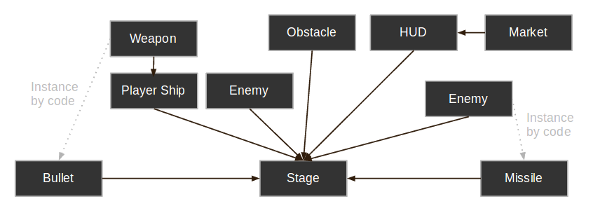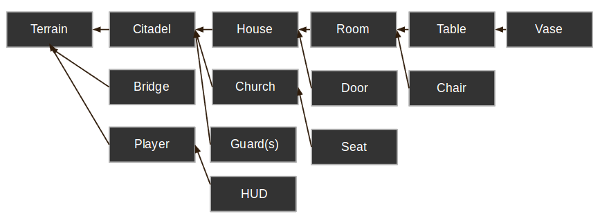Instancing (continued)¶
Recap¶
Instancing has many handy uses. At a glance, with instancing you have:
- The ability to subdivide scenes and make them easier to manage.
- A more flexible alternative to prefabs (and much more powerful given instances work at many levels).
- A way to design more complex game flows or even UIs (UI Elements are nodes in Godot too).
Design language¶
But the real strong point of instancing scenes is that it works as an excellent design language. This is pretty much what makes Godot special and different to any other engine out there. The entire engine was designed from the ground up around this concept.
When making games with Godot, the recommended approach is to leave aside other design patterns such as MVC or Entity-Relationship diagrams and start thinking about games in a more natural way. Start by imagining the visible elements in a game, the ones that can be named not just by a programmer but by anyone.
For example, here’s how a simple shooter game can be imagined:

It’s pretty easy to come up with a diagram like this for almost any kind of game. Just write down the elements that come to mind, and then the arrows that represent ownership.
Once this diagram exists, making a game is about creating a scene for each of those nodes, and using instancing (either by code or from the editor) to represent ownership.
Most of the time programming games (or software in general) is spent designing an architecture and fitting game components to that architecture. Designing based on scenes replaces that and makes development much faster and more straightforward, allowing you to concentrate on the game itself. Scene/Instancing based design is extremely efficient at saving a large part of that work, since most of the components designed map directly to a scene. This way, none or little architectural code is needed.
The following is a more complex example, an open-world type of game with lots of assets and parts that interact:

Make some rooms with furniture, then connect them. Make a house later, and use those rooms as the interior.
The house can be part of a citadel, which has many houses. Finally the citadel can be put on the world map terrain. Add also guards and other NPCs to the citadel by previously creating their scenes.
With Godot, games can grow as quickly as desired, as all it needs is for more scenes to be created and instanced . The editor UI is designed to be operated by non programmers too, so a typical team development process can involve 3D or 2D artists, level designers, game designers, animators, etc all working with the editor interface.
Information overload!¶
Do not worry too much, the important part of this tutorial is to create awareness of how scenes and instancing are used in real life. The best way to understand all this is to make some games.
Everything will become very obvious when put to practice, so please do not scratch your head and go on to the next tutorial!